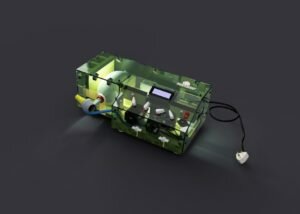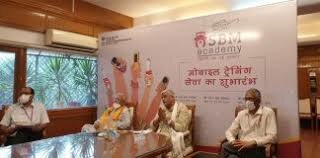IIT Bombay Team develops low-cost mechanical ventilator Ruhdaar
Design has been incubated at Design Innovation Centre, IUST, Pulwama
Mumbai / Pulwama: A team of engineering students from IIT Bombay, NIT Srinagar and Islamic University of Science & Technology (IUST), Awantipora, Pulwama, Jammu and Kashmir is one such group of creative individuals who have come forward to solve the problem of ventilator requirement. The team has come up with a low-cost ventilator using locally available materials.
Here is how the Ruhdaar ventilator, as the team has named it, took birth. The project head Zulqarnain, a first-year student of Industrial Design Centre, IIT Bombay, had gone to his hometown Kashmir, when the institute closed due to the pandemic. On getting to know the ground situation as the pandemic progressed, he understood that there were only 97 ventilators in the Kashmir Valley. He sensed that the need was more and that the concern about shortage of ventilators had become a big worry for many people.

So, Zulqarnain teamed up with his friends P. S Shoib, Asif Shah and Shakar Nehvi from IUST, Awantipora and Majid Koul from NIT Srinagar. Taking assistance from the Design Innovation Centre (DIC) at IUST, the team has been able to design a low-cost ventilator using locally available materials. While their initial aim was to replicate a tried and tested design, as they began to work on it, they developed their own design of the ventilator.
Zulqarnain says “the prototype costed the team around Rs. 10,000 and that the cost will be much lower, when we go for mass production.” He said that while high-end ventilators used in hospitals cost in lakhs of rupees, “Ruhdaar provides necessary functionalities which can provide adequate breathing support necessary to save the life of a critically ill COVID-19 patient.”
Talking about next steps, Zulqarnain said “the team will now go for medical testing of the prototype. Once it is approved, it will be taken for mass production. The effort is to make it amenable for production by small scale industry. The team will not charge any royalty for the product.”
Zulqarnain said that the main problem the team faced was lack of resources. The team tried many designs including a design developed by Massachusetts Institute of Technology, USA. The team came up with their frugal design, considering the resource constraints. The design has been made using advanced software and the team is satisfied with the results, he said.
Asif, who is an alumnus of IUST and CEO of Symcore Technologies, says that “the idea was to design and develop a low-cost alternative to the conventional ventilator. Our team has been able to achieve control of basic parameters such as tidal volume, Breaths per Minute and Inspiratory: Expiratory Ratio and to also monitor pressure continuously during its operation.”
Coordinator, DIC, IUST, Dr. Shahkar Ahmad Nahvi said that the team of youngsters was driven by a desire to make a beneficial contribution to the society in this hour of need. He said that the ventilator is functional from the engineering perspective but requires clearance and validation by the medical community.
Professor, Department of Mechanical Engineering, IUST, Dr. Majid H. Koul said that the low-cost frugal ventilator was developed using components available at DIC. Facilities at the Centre such as 3-D printing and laser-cutting technologies also were instrumental in the success of the prototype. The Centre is an initiative of the Ministry of Human Resource Development, Government of India.
The Government has said that “the COVID-19 infection curve has begun to flatten and that the outbreak is under control”. According to the Health Ministry, among those getting infected, around 80% will experience only mild illness, around 15% will need oxygen support and the remaining 5% who get critical or severe will need ventilators.
Ventilators are thus an important component of the medical infrastructure required for treating infected patients, providing critical breathing support to those falling critically ill. Considering this, the government has been adopting a two-pronged approach, augmenting domestic manufacturing capacity as well as scouting across the world for medical supplies. Accordingly, as per the update given to the Group of Ministers meeting held on April 25, 2020, production of ventilators by domestic manufacturers has already started and orders for more than 59,000 units through nine manufacturers have been placed.
In this context, it is heartening that the Indian inventive and creative spirit has been reaping good fruit in this crisis situation. The entire scientific community, including CSIR and its 30-plus labs, institutes such as IITs and many from the private sector and civil society, have come up with various solutions, each of which contributes in some measure to our battle against the pandemic.






